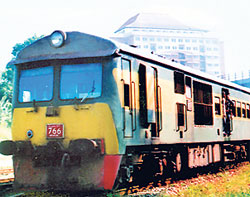December 27 is a red letter day for the railway in Sri Lanka. On this day in 1964, Sri Lanka Railway
celebrated its centenary. Now the railway is 144 years old. It was on this day in 1864 that the first train steamed out from Colombo to Ambepussa.
The railway has come a long way since. At that time, there was no need for signalling, since the trains were run at long intervals. The authorities made sure that the trains were kept well apart so that there would not be any accidents.
You may have noticed how at every station, as a train approaches it the station master in his full
uniform including the cap, is ready to receive the train. The engine driver has an instrument to hand over to the station master and in turn
collects one from him. This is called a 'Tablet' which was introduced as an instrument to ensure the safe
operation of trains on single lines as speeds and frequencies increased.
The tablet gives the authority for the engine driver to proceed to the next section (station). He hands over the tablet at the next station to
indicate that he had the authority to pass the previous section. The
station master gives the tablet only after ensuring by telephoning the next station master that the line is clear for the train to proceed. This happens in single line trains only.
In the early days the signals were operated manually from high level booths built for the purpose. These booths were situated in between
stations with telephone facilities to
indicate the movement of trains. Colour Light Signalling and Centralized Traffic Control was
started in 1959. The railway
telecommunication system has been modernized by the introduction of VHF/UHF radio telecommunication facility between stations and control offices.
The Railway was initially built to transport coffee and tea from the hill country to Colombo for export and goods were for many years the main
source of income. With time and
population growth, however,
passenger traffic increased and in the 1960's overtook freight as the main source of business. The Railway is now primarily engaged in the
transport of passengers,
especially commuters to and from Colombo, offering a vital service and reducing road congestion. It has been estimated that the Railway carries about 105 million passengers, almost 1.6 million metric tonnes of freight per annum.
The building of railway bridges is no easy task. Great care has to be taken in their construction. The Kelani bridge near Colombo (over the Kelani ganga), a work of magnitude, is a structure of 800 feet in length. It composed of 8 spans of 62 1/2 feet built on screw piles, and 12 spans of 25 feet on brick piers. Following a heavy monsoonal rain, this bridge collapsed with the engine and crew on September 20, 1872.
Tunnelling is a masterpiece of
railway engineering, and their
construction with 19th century tools and equipment is a wonder. There are 46 tunnels on the Main Line from Colombo to Badulla. The first tunnel on this line at Mirigama is 274 feet long.
Thereafter, up to Kandy, there are nine tunnels, the longest being 1,095 feet. The longest in the whole line is the Poolbank Tunnel, between Hatton and Kotagala,
having a length of 562m (1,842 ft.), with a curvature in the middle, so that one end of the tunnel cannot be seen from the other end. Tunnels and over-hanging rocks on the incline stand as a lasting monument to the skills of the early British
engineers. There are warning boards in several places to drivers, reading 'Beware of Rock Falls.'
At some places, trains run along the very edge of cliffs, with an almost sheer fall of several hundred feet into the abyss below. Sometimes, when a train enters the tunnel near Idalgashinna, there is sunshine, but when it emerges from the other end, there are clouds laden with mist. The Idalgashinna railway station is by the very precipice overlooking the distant landscape below
Today, Sri Lanka Railways offer several services.
The long distance and Intercity Express service is one of the main services. Intercity Express (ICE) trains offer express service between Colombo-Kandy and Colombo-Vavuniya.
The Railway operates the 'Colombo Service' covering the City suburbs – possibly the most
popular – carrying mainly office
passengers. Season tickets give them a concessionary rate.
The parcel and mail service
transport the country's mail to
distant places. In the mail wagons in the long distance trains, the postal staff spends the night sorting out the mail for distribution to the different post offices on the way.
The mail bags are dropped at the respective stations to be picked up by postal staff.
The freight service is of much
benefit to individuals and
organisations who want to send goods. This is popular particularly among long distances. While
passenger trains have goods wagons for this purpose, there are separate goods trains too.
In several stations, there is
accommodation for passengers.
|






